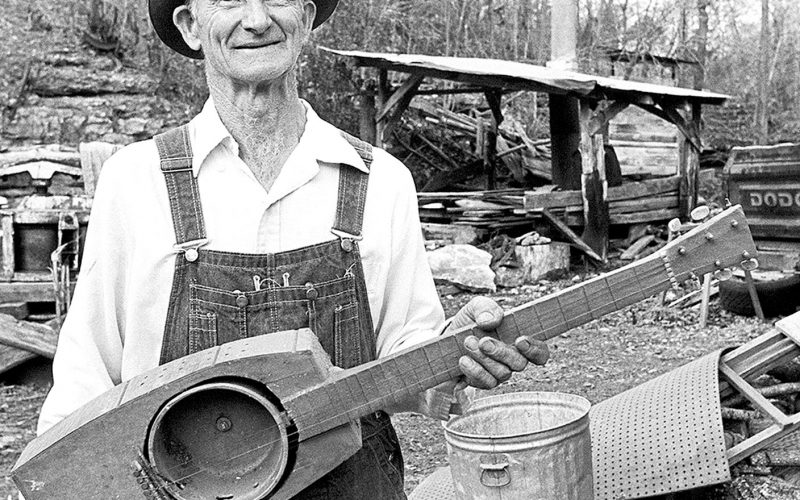Faith becomes art becomes music becomes more
It was around the middle of December 2015 when folklorist and author Robert Cochran of the University of Arkansas was having lunch at the Capital Hotel in Little Rock with Bill Gatewood, Gail Stevens and Jo Ellen Maack of the Old State House Museum.
Cochran, of the university’s Center for Arkansas and Regional Studies, Fulbright College of Arts and Sciences and a frequent guest curator at the museum, was pitching an idea for a new exhibit. When that idea didn’t work out, he mentioned something else that might be better suited for the Old State House.
“Bob said, ‘I just want to put a bug in your ear, and I thought you might be interested,’” says Maack, the museum’s curator.
He told the three about Ed Stilley, the preacher, sawmill worker and subsistence farmer from rugged, isolated Hogscald Hollow in Madison County who built guitars and other stringed instruments out of found parts and scrap wood and gave them away to children. Stilley, who had five children with his wife, Eliza, started making instruments in 1979, believing God had instructed him to do so, and finished more than 200 of the often ungainly, fascinating pieces before arthritis in his hands forced him to quit.
After the lunch “we sat in my office, the three of us, and said, ‘We’ve got to do this,’” Maack recalls of the reaction she shared with museum director Gatewood and exhibit director Stevens.
The result is “True Faith, True Light, the Devotional Art of Ed Stilley,” open at the museum through March 2018. Nearly 30 of Stilley’s instruments — guitars, mandolins and banjos — are hanging in Little Rock along with a display of his tools, the crude wooden jig he used to bend instruments into their sometimes cockeyed shapes and a video featuring an interview with Stilley. There’s even a Stilley guitar that visitors can play.
Arranged in chronological order and representing Stilley’s early, middle and late periods, the instruments begin with a six-string banjo, the first piece he completed. Made of pine with a cooking pot nestled in the middle of its body that acts as a resonator, it looks like some sort of odd shop project.
Mirrors show the backs of some of the pieces and each instrument displayed is accompanied by an X-ray, taken by the Mocek Spine Clinic in Little Rock.
Stilley, who is wheelchair-bound now and lives just off a highway a few miles from the hollow where he spent most of his life, found that placing items inside the bodies of his guitars helped with the sound, so the X-rays reveal carefully placed springs, saw blades, glass medicine bottles and even the odd aerosol can — Right Guard, in one case. For the saddle, where the strings sit on the bridge, he often fashioned bone from the family’s supper scraps. The guitar frets are usually made of brazing rods used by welders.
Stilley, completely self-taught and driven by his beliefs, made his instruments with simple tools, though once he got his hands on an electric router, he began scrawling “True Faith, True Light, Have Faith in God” on each piece.
“There was no tradition of vernacular instrument-making that he plugged into,” says Cochran, author of, among other things, “Our Own Sweet Sounds, A Celebration of Popular Music in Arkansas” and co-author, with Suzanne McCray, of “Lights! Camera! Arkansas!: From Broncho Billy to Billy Bob Thornton” (which also inspired an Old State House Museum exhibit of the same title). “On the other hand, not only did he not learn from anybody who traditionally did it in that area, he didn’t pass it down to anyone. He had no one following him.”

Arkansas Democrat-Gazette/JOHN SYKES JR. – True Faith, True Light exhibit at the Old Statehouse Museum. Unique, odd, handmade guitars from Ed Stilley.
Because he was working independently from tradition, the instruments are examples not so much of folk art but outsider art, Cochran says. Of course, academic distinctions of the genre his instruments belong to would be lost on Stilley.
“He doesn’t think of it as art,” Cochran says. “He thinks of it as [something] produced in obedience to a divine directive. The fact that he didn’t know anything about [making instruments] was immaterial to him. He just started doing it and he figured that the Lord would be pleased.”
Others were also pleased, including Fayetteville musicians Kelly and Donna Mulhollan, who actually play his instruments in their folk duo Still on the Hill.
“There would be no exhibit without Kelly and Donna,” Maack says.
Kelly Mulhollan’s gorgeous 2015 book on Stilley, published by the University of Arkansas Press with photos by Kirk Lanier and an introduction by Cochran, gives the exhibit its name and is a crucial document of Stilley’s life and work.
Mulhollan first met Stilley in 1995. His wife, Donna, was visiting friends, Nina and Tom Luther, who had been neighbors of the Stilleys in the ’70s and had received a guitar from Ed. Donna knew her folk-art-loving husband would appreciate the strange piece.
“She ran home to me and said, ‘You’ve got to see this to believe it,’” Kelly recalls.
The Mulhollans were smitten.
“From the very start, we both felt like we had stumbled into one of the great folk artists of our time,” says Kelly who, with Donna, is a guest curator of the Little Rock exhibition.
__
FAQ
‘True Faith, True Light:
The Devotional Art of Ed Stilley’
WHEN — Through March
WHERE — Old State House Museum, 300 West Markham St., Little Rock
COST — Free
INFO — 501-324-9685; oldstatehouse.com
Sean Clancy
sclancy@arkansasonline.com



